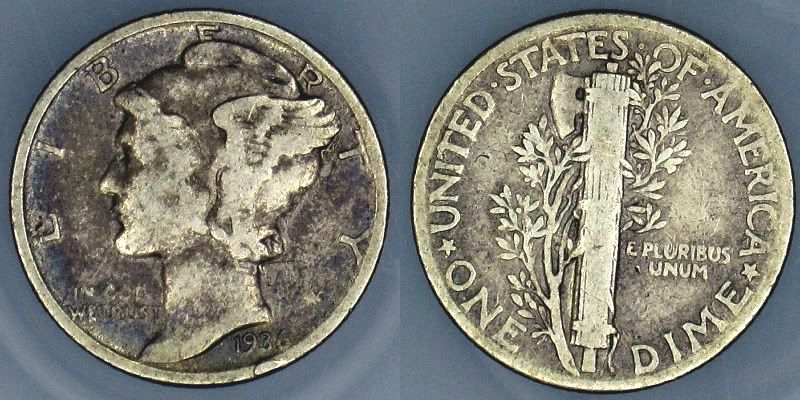Wikipedia article about "touch pieces" (w/Merc dime reference)
 lordmarcovan
Posts: 43,885 ✭✭✭✭✭
lordmarcovan
Posts: 43,885 ✭✭✭✭✭
I've heard the term "touch piece" in reference to certain holed English hammered gold coins, but was surprised to see a picture of a 1936 Mercury dime in the article about it.
<< <i>American silver "Mercury" dimes, especially with a leap year date, are especially lucky. Gamblers' charms are often these dimes, Mercury being the Roman god who ruled the crossroads, games of chance, etc. Although these dimes actually figure the head of Liberty, people commonly mistake it for Mercury. A silver dime worn at the throat will supposedly turn black if someone tries to poison your food or drink. American "Indian Head" cents are worn as amulets to ward off evil or negative spirits. >>
All rather interesting to me, considering my past infatuations with holey coins and love tokens and such.
But I'd never heard the "lucky" legend in reference to Merc dimes, particularly the leap year thing.
Funny how Wikipedia chose a 1936 Merc to illustrate that (edit- or rather the person who edited that article did).
This is the coin which started me collecting, when I found it in my grandmother's silverware drawer on Thanksgiving day in 1976:

So maybe there's something to that whole "lucky" thing, huh.
<< <i>American silver "Mercury" dimes, especially with a leap year date, are especially lucky. Gamblers' charms are often these dimes, Mercury being the Roman god who ruled the crossroads, games of chance, etc. Although these dimes actually figure the head of Liberty, people commonly mistake it for Mercury. A silver dime worn at the throat will supposedly turn black if someone tries to poison your food or drink. American "Indian Head" cents are worn as amulets to ward off evil or negative spirits. >>
All rather interesting to me, considering my past infatuations with holey coins and love tokens and such.
But I'd never heard the "lucky" legend in reference to Merc dimes, particularly the leap year thing.
Funny how Wikipedia chose a 1936 Merc to illustrate that (edit- or rather the person who edited that article did).
This is the coin which started me collecting, when I found it in my grandmother's silverware drawer on Thanksgiving day in 1976:

So maybe there's something to that whole "lucky" thing, huh.
0

Comments
Indian Head cents are mentioned in To Kill a Mockingbird, as being "strong magic" and good luck. Capt. Henway,
I remember you discussed that in your foreword to Rick Snow's Guide Book of Flying Eagle and Indian Head Cents.
Here are some thoughts on Wikipedia as a research source:
“The Coin Show”
Episode 66, August 2013.
American Numismatic Association, Chicago, Illinois.
http://www.coinshowradio.com/Episode_66.html
Mike Nottelmann, Matt Dinger, Dennis Tucker.
Matt: “I guess, popping into my head, if I had to think of one thing that could be a threat to publishing, it would be misinformation. You see a lot more of that in places like the Internet than you would find in published books: people that think they know what they’re talking about, that don’t. You see that a lot, and sometimes people take that, the numismatic forums and stuff, people may take that as being what it is, when it’s not.”
Dennis: “As the Gospel.”
Matt: “Right, which it’s not.”
Dennis: “And even Wikipedia, which people think of as being an encyclopedia and a legitimate source of completely accurate information, there’s a lower standard, a lower bar, for vetting that information, fact-checking.”
Matt: “Sure.”
Mike: “And they can always go back and change it, which is—” <laughter>
Dennis: “I could go onto Wikipedia right now and put in hundreds of pages of misinformation if I wanted to.”
Mike: “Absolutely.”
Dennis: “I could change dates; I could do it in ten seconds. Anybody can do that. I wouldn’t, of course; you and I wouldn’t.”
Mike: “And you can’t do that with a research reference.”
Dennis: “You can’t do that with a book; exactly. I mean, I suppose you could, but you’re going to lose your reputation and not sell many copies.”
I still love it, heaven help me.